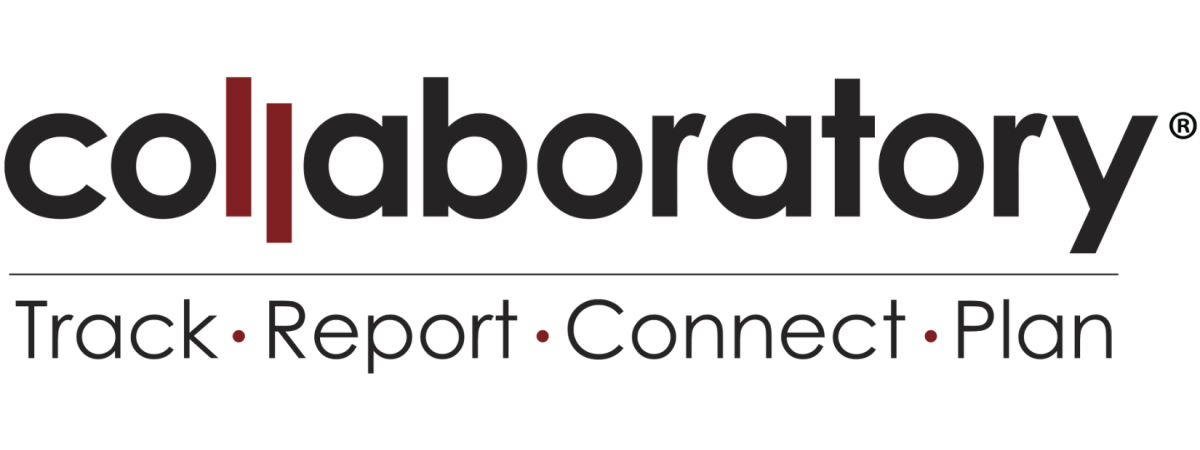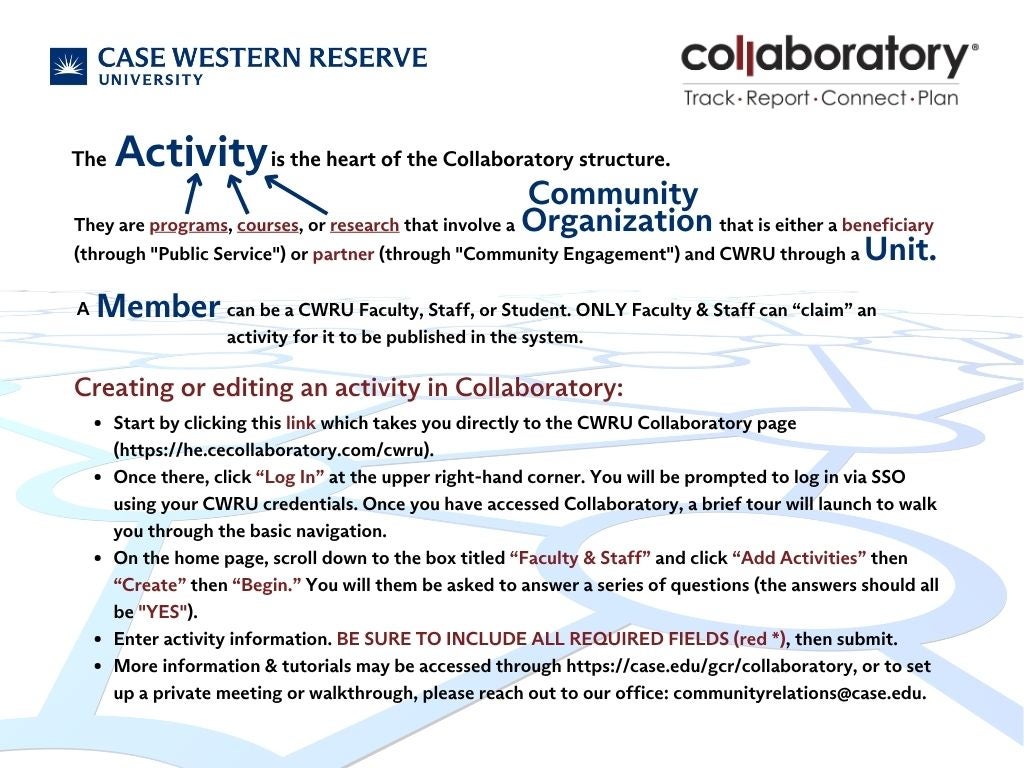EASY BUTTON!: Submit activity information by clicking on this link. All you need to do is approve the activity when you receive the automated Collaboratory email. That's it! Please note that only CWRU faculty and staff have access to approval permissions.
In the spirit of recognizing and encouraging CWRU's commitment to community engagement and public service, we are leveraging Collaboratory to identify and track these activities more intentionally across campus.
We are focused on documenting ACTIVITIES linked to the following:
- COURSES with a community engagement or public service integration (e.g.: The City as Museum: Monuments & Memory)
- RESEARCH with a community engagement or public service association (e.g.: Nourishing Power Network; Cleveland Schools Lead Screening Project)
- PROGRAMS with a community engagement or public service mission (e.g.: CCEL Serves; Geriatric Dentistry - Lifelong Smiles)
Each of the activities must identify a COMMUNITY PARTNER to be included in the publicly-searchable Collaboratory database. Everyone's participation and contribution will ensure a comprehensive picture of our engagement and service landscape.
IMPORTANT! Please do NOT delete or archive your inactive entries. This is a longitudinal database that allows for searches over periods of time and the inclusion of legacy activities is vital to a strong data set! You may indicate an "end date" on your entry instead. If you need access to an activity or assistance with it, please reach out to us at cwrucollaboratory@case.edu. Thank you!
Based on criteria established by the Carnegie Elective Classification for Community Engagement:
"Community engagement describes collaboration between institutions of higher education and their larger communities (local, regional/state, national, global) for the mutually beneficial exchange of knowledge and resources in a context of partnership and reciprocity. The purpose of community engagement is the partnership of college and university knowledge and resources with those of the public and private sectors to enrich scholarship, research, and creative activity; enhance curriculum, teaching, and learning; prepare educated, engaged citizens; strengthen democratic values and civic responsibility; address critical societal issues; and contribute to the public good."
Collaboratory organizes activities into two categories: Community Engagement and Public Service. While Community Engagement and Public Service both occur in community settings, involve interaction with the community, and integrate some form of service, they have very distinct goals and processes.
As the field of higher education community engagement has developed, important clarification has occurred to help institutions strengthen their work and accomplish the goals intended for their community interactions. Specifically:
- Community Engagement is a process by which an institution works with community partners to co-create and implement mutually beneficial activities distinguished by collaboration and reciprocity. The exchange of expertise and ideas between academic and external community partners leads to co–creation of knowledge and activities that generate benefits for the academic institution, as well as community partners. The “community” in community engagement is not defined by sector, such as private or public, for-profit or nonprofit, rather, community is broadly defined to include individuals, groups, and organizations external to campus that use collaborative processes for the purpose of contributing to the public good.
- Public Service (sometimes referred to as community service or outreach) occurs when an institution provides expertise, resources, and services to or for community individuals, groups, organizations, and the general public. External entities may invite, host, attend, participate, and benefit from the activity, but the primary responsibility for the design, delivery, and assessment of the activity is shaped by the academic institution.
When a Collaboratory user begins to create an Activity, Collaboratory assists in identifying that Activity as Community Engagement or Public Service through a decision tree.
- from the CollaboratoryR Help Files
Claiming and editing an activity in Collaboratory:
- Start by clicking this link to take you to the CWRU Collaboratory page (or click on the link in your invitation email from CWRU Collaboratory).
- Once at the CWRU landing page, click “Log In” at the upper right-hand corner. You will be prompted to log in via SSO using your CWRU credentials. Once you access Collaboratory, a brief tour will launch to walk you through the basic navigation.
- Optional but helpful: Take a moment to update your Institutional Profile (you can include your bio, links to your online CV, add a photo) to give more depth to your submission.
- Access the “Dashboard” menu on the left sidebar by clicking on the circle with three lines in the top left corner. Click on the “Invitations” link and then “Claim Proxied Content.” This will open a menu to the right where you can claim and edit your activity. You will then be able to enter information regarding your activity.
- The description does not need to be long (a paragraph at most—likely a cut-and-paste from your website or other documents).
- When you are identifying you target population(s), please be as specific as possible. However, if your program/course/research activity includes everyone, please only click “general public” not every category that makes up the general public.
- All mandatory fields will need to be completed before the activity can be submitted (at the submission page, check blue text for any incomplete information).
The following questions should be true for your activity:
-
Does the Activity directly relate to a public priority or issue?
-
Does the Activity involve one or more external community groups, organizations, agencies, or neighborhoods?
-
Are mutual benefits articulated by both the institution and the external community group, organization, agency, or neighborhood?
-
Does the design or implementation of the Activity include an exchange of knowledge or expertise with the external community group, organization, agency, or neighborhood?



